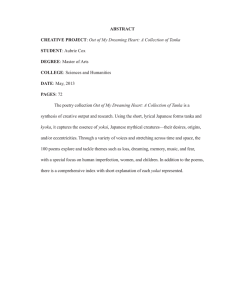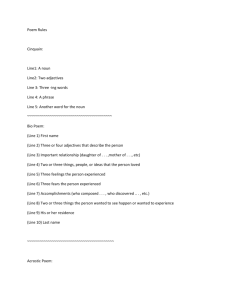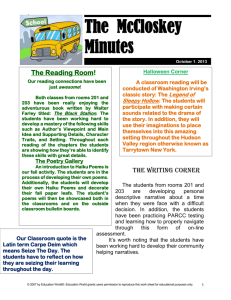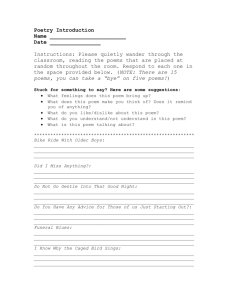Victorian and Japanese Poetry
advertisement
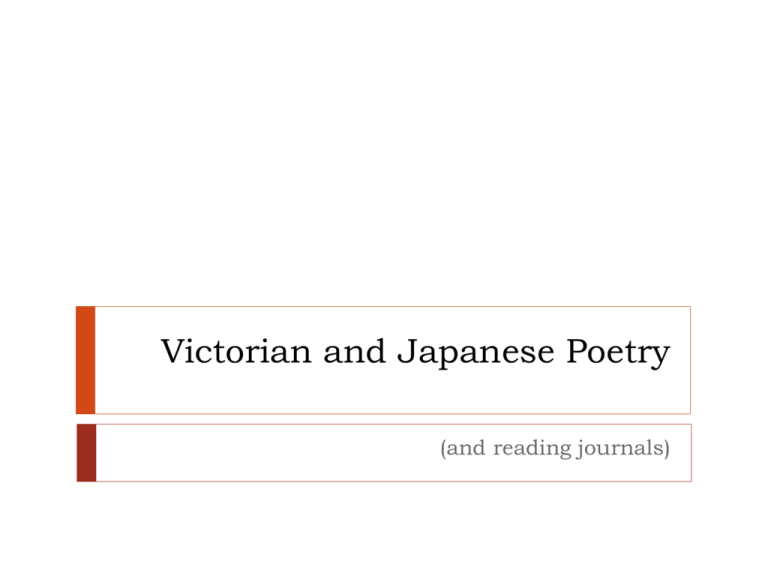
Victorian and Japanese Poetry (and reading journals) Victorian Literature From the 19th century Victorianism The Victorian era covers two-thirds of the 19th century, from 1840-1900. It is named after Queen Victoria of England, who ruled from 1837-1901. Victorian Literature Literature in the Victorian era formed a kind of link between the earlier Romantics and the later writing of the 20th century. Many novels came from this time period. They were usually about hard work and perseverance paying off in the end, the good guy winning, and the bad guy being punished. Children’s literature was also invented during this time. Victorian Literature Authors you might know… Sir Arthur Conan Doyle Alfred, Lord Tennyson (Morte d’Arthur) A.E. Houseman Charles Dickens Joseph Conrad (Have you seen Apocalypse Now? He wrote the book.) Bram Stoker (he wrote Dracula) Lewis Carroll (Alice in Wonderland and Through the Looking Glass) (he wrote Sherlock Holmes) H.G. Wells (the father of science fiction) (wrote Ms. Spiceland’s favorite poem) The Kraken Today we’re reading “The Kraken” by Alfred, Lord Tennyson (your favorite author!) • In legends, the Kraken is a giant monster that lives in the sea. •You may know of the Kraken from Pirates of the Caribbean: Dead Man’s Chest The Kraken Below the thunders of the upper deep; Far, far beneath in the abysmal sea, His ancient, dreamless, uninvaded sleep The Kraken sleepeth: faintest sunlights flee About his shadowy sides: above him swell Huge sponges of millennial growth and height; And far away into the sickly light, From many a wondrous grot and secret cell Unnumbered and enormous polypi Winnow with giant arms the slumbering green. There hath he lain for ages and will lie Battening upon huge sea-worms in his sleep, Until the latter fire shall heat the deep; Then once by man and angels to be seen, In roaring he shall rise and on the surface die. The Kraken Now that we’ve read and talked about this poem, we’re going to do some writing on about it. Get out a sheet of paper… Reading Journals Reading Journals First, write the title of the poem at the top of the sheet. Now, write the Works Cited entry for the poem. The format for the Works Cited entry for poems in our textbook is on the next slide. COPY DOWN THE FORMAT! You will need it! Regular poem: Author Last Name, First Name. “Title of Poem.” Literature: Language and Literacy. Upper Saddle River: Prentice Hall, 2010. Page number. Poem with a Translator: Author Last Name, First Name. “Title of Poem.” Literature: Language and Literacy. Trans. Translator name. Upper Saddle River: Prentice Hall, 2010. Page number. Reading Journals Important Note! If the poem does not have a title, use the first line as the title. Next, write three quotes from the poem. I know – the poem is short! They don’t have to be very long quotes (5-10 words, up to one line) Don’t forget to include the parenthetical citation! Now, write a paragraph that summarizes the poem. Explain any characters (or monsters) and what’s going on. Reading Journals Finally, write a paragraph analyzing the poem.You’ll want to write about how the author uses his writing to get his point across. For example, the Kraken is supposed to be super scary. Tennyson uses words like “sickly light” (l. 7) and “In roaring he shall rise” (l. 15) to get that across. You should use one or two literary terms, such as… Metaphor Imagery Alliteration Simile Hyperbole Allusion Personification Synecdoche Rhyme Tanka Poems Traditional Japanese Poetry Tanka Poems You have probably heard of haiku before. They’re those little Japanese poems that are three lines long Here’s my favorite: Haiku are awesome But sometimes they don’t make sense Refrigerator Haiku have a specific format: Three lines long 5 syllables in the first line, 7 in the second, 5 in the third. Traditional Japanese haiku are usually about nature. Tanka Poems Tanka poems are similar to haiku, but it is a much older form. Tanka poems are longer than haiku. While a haiku goes 5-75, a tanka goes 5-7-5-7-7. Tanka Poems Tanka poems are often translated from Japanese to English. Sometimes, the syllable counts change in the translation. Because they are so short, tanka poems usually focus on a single, strong image or statement. Tanka poems also do not have titles. Tanka Poems The clustering clouds – Can it be they wipe away The lunar shadows? Every time they clear a bit The moonlight shines the brighter. -Minamoto no Toshiyori Translated by Donald Keene When I went to visit The girl I love so much, That winter night The river blew so cold That the plovers were crying. -Ki no Tsurayuki Translated by Geoffrey Bownas One cannot ask loneliness How or where it starts. On the cypress-mountain, Autumn evening. -Priest Jakuren Translated by Geoffrey Bownas Was it that I went to sleep Thinking of him, That he came in my dreams? Had I known it a dream I should not have wakened. -Ono Komachi Translated by Geoffrey Bownas Tanka Poems The tanka poems and “The Kraken” both used strong imagery and descriptive language. Other than length, what differences do you see between the tanka poems and “The Kraken”? What similarities do you see? Reading Journals Grab a sheet of paper from your notebook and write “Tanka Poems” at the top! We’re going to follow the same format for this journal as we did for “The Kraken.” Here are the parts you need to have: Works Cited entry Three quotes with parenthetical citations One paragraph summarizing the poem One paragraph analyzing the poem (using literary terms)

